copper trough history
Mining history
There are many plentiful materials on this planet. Early humans used stone, wood, and any natural fibers that were available. Useful, implements could be made of these naturally occurring materials. With the discovery of fire, metals could be extracted from special rocks and forged into implements. Copper was certainly one of these earliest materials used and may have been around since 8000 B.C. Copper can be used for  making tools, weapons, cooking utensils and decorations. Some 5800 years ago bronze, an alloy of copper and tin, was invented. During this same time the first extraction of gold and silver from the rocks was also developed.
making tools, weapons, cooking utensils and decorations. Some 5800 years ago bronze, an alloy of copper and tin, was invented. During this same time the first extraction of gold and silver from the rocks was also developed.
Copper and the copper alloys are some of the most versatile materials available and are used for applications in every type of industry with world consumption of exceeding 14 million tonnes per annum.  Besides good conductivity the properties include strength, hardness, ductility, resistance to corrosion, wear and shock, low magnetic permeability, an attractive range of colors together with ease of machining, forming, polishing and plating. Over the years a number of materials have been developed giving combinations of these properties that are optimum for a very wide variety of applications.
Besides good conductivity the properties include strength, hardness, ductility, resistance to corrosion, wear and shock, low magnetic permeability, an attractive range of colors together with ease of machining, forming, polishing and plating. Over the years a number of materials have been developed giving combinations of these properties that are optimum for a very wide variety of applications.
Brasses and Bronzes are probably the most well-known families of copper-base alloys. Brasses are mainly copper and zinc. Bronzes are mainly copper along with alloying elements such as tin, aluminum, silicon or beryllium.
 Sixty Centuries of Copper Since primitive man first discovered copper, the red metal has constantly served the advancement of civilization. Copper is man's oldest metal, dating back more than 10,000 years. A copper pendant discovered in what is now northern Iraq goes back to about 8700 B.C. Archaeologists probing ancient ruins have discovered that this enduring metal was a great boon to many peoples. Copper probably first came into use as the earliest non-precious metal employed by the Sumerians and Chaldeans of Mesopotamia, after they had established their thriving cities of Sumer and Accad, Ur, al'Ubaid and others, somewhere between 5,000 and 6,000 years ago. These early peoples developed considerable skill in fabricating copper and from these centers the rudiments of craftsmanship spread to the river-dwelling people of Egypt, where it continued to flourish for thousands of years long after their own civilization had degenerated.
Sixty Centuries of Copper Since primitive man first discovered copper, the red metal has constantly served the advancement of civilization. Copper is man's oldest metal, dating back more than 10,000 years. A copper pendant discovered in what is now northern Iraq goes back to about 8700 B.C. Archaeologists probing ancient ruins have discovered that this enduring metal was a great boon to many peoples. Copper probably first came into use as the earliest non-precious metal employed by the Sumerians and Chaldeans of Mesopotamia, after they had established their thriving cities of Sumer and Accad, Ur, al'Ubaid and others, somewhere between 5,000 and 6,000 years ago. These early peoples developed considerable skill in fabricating copper and from these centers the rudiments of craftsmanship spread to the river-dwelling people of Egypt, where it continued to flourish for thousands of years long after their own civilization had degenerated.
 |
From the earliest Dynasties onwards, Egypt developed a very high degree of civilization, and the exploitation of metals-copper, bronze and precious metals such as gold and silver-was an essential part of their culture. The Egyptians are commonly credited with inventing the lost wax or cire perdue method of casting metal. This was known too in China, but apparently only at a much later date. By Egyptian belief, when a died his heart had to weighed in the presence of Osiris, the great god of the dead. The man's soul was assumed to be represented by his heart, the weight of which must exactly balance that of a feather - the symbol of righteousness; if it did so, the soul of the deceased was taken into the company of the gods. For ordinary people, this weighing must have left heaven rather empty. Many hieroglyphics show this ceremony, together with detailed drawings of the balances employed. |
| A set of Egyptian bronze animal weights, circa 1450 B.C. http://www.copper.org |
Several thousand years before the Christian era a flourishing civilization existed in Hindustan,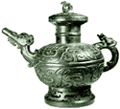 and sites on the Indus are now being systematically examined. Farther east, in China, the general use of metals dates back to at least 2000 B.C., and by 1200 B.C. bronze foundry work had reached a high state of perfection. Although the Chinese claim to have used coins for money thousands of years before the Christian Era, none has been found which is earlier than the 3rd Century B. C. By then their well-known 'cash' had been introduced; this comprised copper discs with square holes in the centre through which string was threaded. This type of coinage lasted in China right down to the 20th Century.
and sites on the Indus are now being systematically examined. Farther east, in China, the general use of metals dates back to at least 2000 B.C., and by 1200 B.C. bronze foundry work had reached a high state of perfection. Although the Chinese claim to have used coins for money thousands of years before the Christian Era, none has been found which is earlier than the 3rd Century B. C. By then their well-known 'cash' had been introduced; this comprised copper discs with square holes in the centre through which string was threaded. This type of coinage lasted in China right down to the 20th Century.
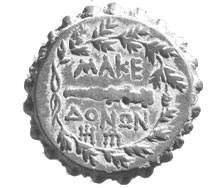 The Greeks mainly employed a silver coinage. It was beautifully minted, and bronze dies were used exclusively. Armour, weapons, tools, vases, cauldrons (sometimes with bronze tripods), beautiful ornamental mirrors of many kinds, razors, bracelets and brooches in copper or bronze were common features of the ancient Greek world. The temples themselves were of stone, usually with stone or wooden roofs; but copper was also used for temple roofs as far back as Hesiod's day (about 650 B.C.). The Greeks also used their skill to produce exquisite little figures only a few inches high, such as the supports or handles for bowls, the handles of mirrors and caskets, armor and a hundred other items.
The Greeks mainly employed a silver coinage. It was beautifully minted, and bronze dies were used exclusively. Armour, weapons, tools, vases, cauldrons (sometimes with bronze tripods), beautiful ornamental mirrors of many kinds, razors, bracelets and brooches in copper or bronze were common features of the ancient Greek world. The temples themselves were of stone, usually with stone or wooden roofs; but copper was also used for temple roofs as far back as Hesiod's day (about 650 B.C.). The Greeks also used their skill to produce exquisite little figures only a few inches high, such as the supports or handles for bowls, the handles of mirrors and caskets, armor and a hundred other items.
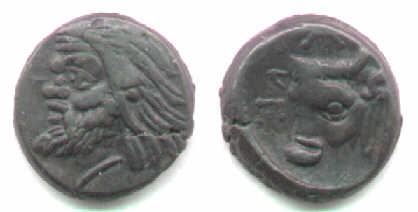 A Greek copper coin of the city Pantikapion, from the 4th century BC. Pan (notice the pun on the name of the city) / bull's head.
A Greek copper coin of the city Pantikapion, from the 4th century BC. Pan (notice the pun on the name of the city) / bull's head.
The Greeks used only a few copper coins, but the Romans had a large variety of copper money. As civilization progresses new materials are developed but older ones are rarely discarded; rather are they used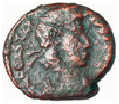 more for specialized purposes, particularly if they are comparatively scarce. This was the fate of bronze in Rome, after the introduction of iron smelting about 600 to 700 B.C. In this case the durability of copper and its principal alloy, bronze, and their attractive appearance, ensured continuing use of both metals although on a more limited scale. Moreover, the discovery soon afterwards of a new copper alloy, brass, opened up endless fresh opportunities for the coppersmith's art. Romans temples had bronze doors and the vestibules were sometimes enclosed by bronze grilles; but only the great bronze doors of the Pantheon still remain unmelted.
more for specialized purposes, particularly if they are comparatively scarce. This was the fate of bronze in Rome, after the introduction of iron smelting about 600 to 700 B.C. In this case the durability of copper and its principal alloy, bronze, and their attractive appearance, ensured continuing use of both metals although on a more limited scale. Moreover, the discovery soon afterwards of a new copper alloy, brass, opened up endless fresh opportunities for the coppersmith's art. Romans temples had bronze doors and the vestibules were sometimes enclosed by bronze grilles; but only the great bronze doors of the Pantheon still remain unmelted.
A l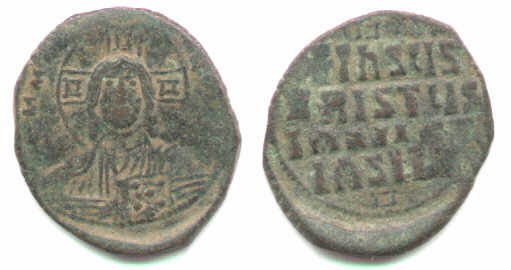 arge (32 mm) Byzantine copper coin of Basil II ("the Bulgar Slayer") and Constantine VIII, AD 976 - 1028. The obverse shows a facing bust of Christ (with a halo) and the reverse says "Jesus Christ, ruler of kings" in Greek.
arge (32 mm) Byzantine copper coin of Basil II ("the Bulgar Slayer") and Constantine VIII, AD 976 - 1028. The obverse shows a facing bust of Christ (with a halo) and the reverse says "Jesus Christ, ruler of kings" in Greek.
A good picture of copper mining, metallugy, and use in the Middle Ages and Renaissance ca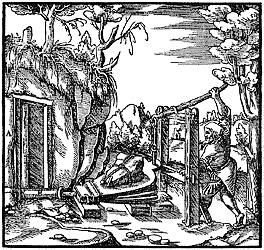 n be obtained from De Re Metallica, by Georgius Argicola, published in 1556. Agricola gave detailed descriptions of mining techniques and equipment, mine surveying, mining law, mining industrial organization, copper minerals, vein deposits and ways to recognize them, assay techniques to determine the amount of copper contained in an ore rock, ways to smelt copper into cakes, and to purify it. It is apparent reading his work that mining had progressed only slightly from the days of the Romans. Without explosives, rocks were still plucked from shafts and tunnels with picks and shovels. Tunnels were supported with timber (they are still), an d miners and ore were raised and lowered using winches. Techniques existed to drain water away from deep shafts, and to blow fresh air into them.
n be obtained from De Re Metallica, by Georgius Argicola, published in 1556. Agricola gave detailed descriptions of mining techniques and equipment, mine surveying, mining law, mining industrial organization, copper minerals, vein deposits and ways to recognize them, assay techniques to determine the amount of copper contained in an ore rock, ways to smelt copper into cakes, and to purify it. It is apparent reading his work that mining had progressed only slightly from the days of the Romans. Without explosives, rocks were still plucked from shafts and tunnels with picks and shovels. Tunnels were supported with timber (they are still), an d miners and ore were raised and lowered using winches. Techniques existed to drain water away from deep shafts, and to blow fresh air into them.
After Rome fell to Barbarian invasions in 410 A.D. and again in 455 A.D., Europe was plunged into a time of war and uncertainty. Skills were forgotten. Trade stopped. Mining, except for iron for weapons and tools, was nearly abandoned. This period is called the Dark Ages.
In Germany, in the Kingdom of Otto, in 938, a German nobleman was riding his horse, Ramelus. The nobleman was hunting near the town of Goslar in the Harz Mountains. He tied the reins to a tree when he dismounted to hunt. Ramelus was impatient and pawed the earth. When the nobleman returned, he saw metals gleaming in the horse's little excavation. Miners realized that the horse had uncovered a 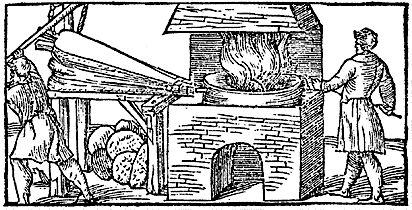 vein of silver, lead, and copper. This mine was named Rammelsberg, after the horse Ramelus.
vein of silver, lead, and copper. This mine was named Rammelsberg, after the horse Ramelus.
Rammelsberg became the most important source of silver, lead and copper in central Europe. Over a thousand years later, it still produces wealth. Like the gold rush in the United States, it inspired German expansion to the east, to search for more mi neral deposits. It also trained miners in the skills lost to the Dark Ages, in mining and prospecting.
The result of mining in central Europe was to bring wealth and power to the German and Austrian princes and emperors of the region. German technical know-how became important in the subsequent history of Europe.
The first explosives to crack rocks in a mine probably were used in the Hungarian Erzgebirge in 1627. There, the holes that had been drilled in the rock were packed with black powder.
Steam engines first pumped water out of mines in England, in Cornwall in 1711. Thomas Newcomen invented the steam-powered pump. James Watt improved it. While tin was the most valuable metal mined in Cornwall, copper also was found in the mines. Two mines alone produced twenty million dollars worth of tin and copper. Mining continues in Cornwall today, although far less than during the Nineteenth Century. But the invention of a steam-powered machine to assist in mining brought about the Industrial Revolution, and the modern world as we know it.
| Interesting facts from around the world
* Water supply systems of the Great Pyramid (Cheops’ Pyramid) is constructed partly of copper tubes (over 4500 years ago). Now we sells copper tubes to our customers in Egypt. *The twin pillars that once stood before the porch of Solomon's Temple at Jerusalem were of bronze. They were about 3 in. thick, 6 ft in diameter, and more than 26 ft high.
|
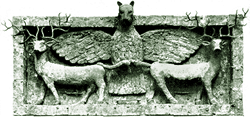 |
| Copper-relief found at Al'Ubaid, near Ur, dating from about 3100 B.C. Known as the Imdugud Relief, it is entirely of copper and shows a lion-headed eagle holding two stags by their tails. http://www.copper.org |
 * One of the Seven Wonders of the Ancient World, the celebrated Colossus at Rhodes, was the largest of many colossal statues of the Sun-god upon the island; it stood 105 ft high and consisted entirely of bronze. It was made by Chares of Lindus, one of the most famous bronze sculptors of antiquity, and took twelve years to manufacture and erect (292 to 280 B.C.).
* One of the Seven Wonders of the Ancient World, the celebrated Colossus at Rhodes, was the largest of many colossal statues of the Sun-god upon the island; it stood 105 ft high and consisted entirely of bronze. It was made by Chares of Lindus, one of the most famous bronze sculptors of antiquity, and took twelve years to manufacture and erect (292 to 280 B.C.).
*The Romans had copper alloy horns and bronze trumpets called buccinas. The latter were mainly military instruments and had only one or two notes, like most of the other trumpets of that period.
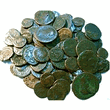 *Copper tubes were used in the time of the Roman Empire. Even nowadays it is possible to see the remnants of copper water supply systems in the archeological site in Herculaneum (that was destroyed after eruption of Vesuvius in 79 A.C.).
*Copper tubes were used in the time of the Roman Empire. Even nowadays it is possible to see the remnants of copper water supply systems in the archeological site in Herculaneum (that was destroyed after eruption of Vesuvius in 79 A.C.).
*One of the famous Dead Sea Scrolls found in Israel is made of copper instead of more fragile animal skins. The scroll contains no biblical passages or religious writings - only clues to a still undiscovered treasure.
* Copper tubes were used in the Mid 19 th century in English breweries. Since then they are more and more used for water supply installations all over Western Europe instead of lead ones.
* Of all materials used by the man, copper is given a special priority since it influenced the development of civilization to the utmost. It is used for conveyance of water and gas, conduction of heat and electricity, and in various telecommunication systems...Even one age of human civilization - the Copper Age - was named after it. 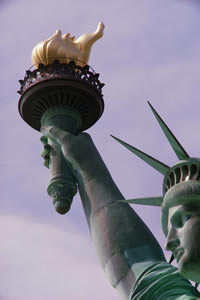
* The Statue of Liberty in the United States is coated with 80 tons of copper.
*The U.S. nickel is actually 75% copper. The dime, quarter, and half dollar coins contain 91.67% copper and the Susan B. Anthony dollar is comprised of 87.5% copper.
*Ten thousand years ago, cave dwellers used copper axes as weapons and tools for survival. Today, high tech surgeons save lives and precious blood by using copper-clad scalpels. The copper conducts an electric current that heats the scalpel to make it self-cauterizing.
*A Boeing 727 airplane uses 9,000 pounds of copper.
*184,000 tones of copper were used for the first production of the eight new Euro coins.
Source: http://www.copper.org
http://www.unr.edu
In our offer we also have:
● Copper tubes for LPG vehicles ![]()
Click on the links above to see more product details.
For information for sizes and prices please email us at info@copper-tubes.net
or telephone us on +381(0)11 3970 300
If you need any further information, don't hesitate to contact us.
 sitemap
sitemap
Search
eng rus ger pol ita ned swe jpn srb cro esp chi por kor hun fra
Product range
- Copper tubes and pipes:
-
 Soft copper tubes
Soft copper tubes -
 Half-hard copper tubes
Half-hard copper tubes -
 Hard copper tubes
Hard copper tubes -
 PVC coated copper tubes
PVC coated copper tubes
-
 Copper pipes for LPG
Copper pipes for LPG -
 Tubes for refrigeration and AC
Tubes for refrigeration and AC Tubes for plumbing
Tubes for plumbing -
 Capillary tubes
Capillary tubes -
 Conductors, cables and wire
Conductors, cables and wire -
 Enamelled copper wire
Enamelled copper wire -
 Copper bars, rods and plates
Copper bars, rods and plates Brass and bronze bars and tubes
Brass and bronze bars and tubes -
 Copper strips and sheets
Copper strips and sheets -
 Copper, bronze, brass ingots
Copper, bronze, brass ingots -
 Trolley wire
Trolley wire -
 Copper fittings (pdf)
Copper fittings (pdf) -
 Contact details
Contact details -
 Careers
Careers
Other products:
Interesting facts
-
 Tables of standards
Tables of standards -
 Copper through history
Copper through history -
 Application of copper tubes
Application of copper tubes -
 Advantages of copper tubes
Advantages of copper tubes -
 Copper ore
Copper ore -
 Brass and bronze
Brass and bronze -
 Copper-containing minerals
Copper-containing minerals -
 Copper facts
Copper facts -
 Symbols of copper
Symbols of copper -
 Copper coins
Copper coins -
 The Baghdad Battery
The Baghdad Battery -
 Links
Links